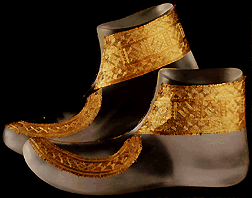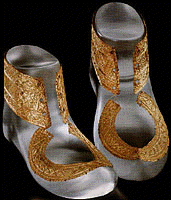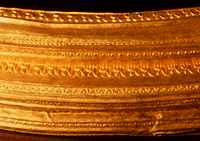

Two views of gold shoe ornaments, over modern synthetic shoe reconstructions.
Ankle band: 35 cm x 6.5 cm
Toe band: 2.8 cm wide
Foil thickness: .2 mm
Very thin gold foil ornaments in the form of slender strips were sewn onto the leather (probably -- none is preserved) of the shoes. The horseshoe shape of the toe bands was made by connecting two asymmetrically curved bands with a small piece of foil; the toes of the shoes undoubtedly pointed upward.
The design is worked in repoussée in three registers. These
are separated by groups of
two horizontal ridges, a common motif in the Hochdorf tomb. However,
the rest of the ornament is remarkably different. Instead oflong,
uninterrupted horizontal rows of discrete shapes seen on the other
gold foil ornaments, such as the belt
cover, the neck ring (right) or
the dagger cover, the shoe foils divide
the registers into vertical and diagonal fields. The most common
Hochdorf motif, the concentric circles or hollow ring, appears on the
shoes as well, but here they are not simply lined up, as on the gold
armband or drinking
horn foils, but are arranged in complex patterns.
separated by groups of
two horizontal ridges, a common motif in the Hochdorf tomb. However,
the rest of the ornament is remarkably different. Instead oflong,
uninterrupted horizontal rows of discrete shapes seen on the other
gold foil ornaments, such as the belt
cover, the neck ring (right) or
the dagger cover, the shoe foils divide
the registers into vertical and diagonal fields. The most common
Hochdorf motif, the concentric circles or hollow ring, appears on the
shoes as well, but here they are not simply lined up, as on the gold
armband or drinking
horn foils, but are arranged in complex patterns.
The toe bands feature a wide central register flanked by two very
narrow rows of "Z"-shapes. The central ornament consists of two rows
of three ridges, each
arranged as opposed zig-zags which intersect so that diamond-shaped
fields are formed. There is a "donut" at the center of each framed
diamond; small dart-shaped punches surmounted by two short ridges
truncate the triangular fields outside the diamonds.
ridges, each
arranged as opposed zig-zags which intersect so that diamond-shaped
fields are formed. There is a "donut" at the center of each framed
diamond; small dart-shaped punches surmounted by two short ridges
truncate the triangular fields outside the diamonds.
The same pattern, without the "Z" border, is repeated along the
top and bottom of the ankle bands. In between, square fields or
metopes are separated by vertical rows of concentric rings flanked by
three parallel ridges. The square fields are subdivided by a central
diamond. In addition, diagonal lines bisect the triangular areas
outside the diamonds and divide the diamonds into four smaller
diamonds, each with its concentric ring. 
The patterns on the shoe foils thus resemble the other gold foil in the tomb less than they do the textile patterns, which also consist chiefly of chevron or diamond-shaped fields and diagonal patterns. Perhaps Hallstatt-period shoes were embroidered or woven, and the foils imitate shoe patterns, or perhaps the chieftain's shoes were simple and unadorned. In any case, the shoe foils are clear examples of gold ornamental additions fashioned specifically for the tomb and not used in life, a part of the burying group's project of covering the chieftain with gold literally from top to toe.
It is interesting to note that the ornaments (and presumably shoe) for the right foot were put on the left foot, and vice versa.
Biel 1985, 81 ff.
Stuttgart: Württembergisches Landesmuseum.